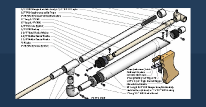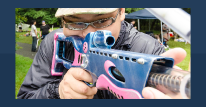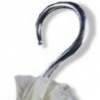Lets turn this,

Into this,

You will need(with part numbers)
.53 PETG - McMaster 2044T43
5/8 in OD Clear PVC - McMaster 53945K15
3/4 in OD Clear PVC - McMaster 53945K16
1/8 in Polycarbonate Sheet - McMaster 8574K26
Miniature Air Pressure Gauge - Mcmaster 38105K51
8mm Vinyl Tubing - McMaster 5233K117
3/4 in OD Neoprene Washer - Bought at my local Ace
Ace Repair Kit - 45503 or 45478
8-32 Nylon nuts & bolts - Bought at my local Ace
1/2 in Wooden Dowel Rod - Also from the local Ace
8mm SMC Residual Pressure Relief Valve - On Amazon
Bell Airstrike Dual Action Frame Pump - Also on Amazon
Dis-assembly
1) Remove the 2 screws from the pump handle, the 12 screws in the body, and pry off the 2 black accent pieces.

2) Clam shell the blaster and remove the trigger, pump, and tank assembly. Be careful not to lose the air seal or its spring.

3) Remove and discard the air hose, but retain the nuts.

4) Remove the turret assembly and the trigger actuator by removing one screw. Separate the rotation mechanism from the turret and set it aside.

Turret Mods

1) Mark the air seal and cut out a hole the size of the PETG, I use a scrap of tubing and a drum sanding mandrel to keep it centered. Cut out the air restrictors.

2) Make marks 3/8in from the tip and 1in from the base of the barrels, and then cut. Throw away the middle bit.

3) If you look closely you will see that there are 3 different I.D.’s in the barrels, this is what will hold our .53 PETG barrels in place.

4) Flatten any rough or uneven edges by sanding on a flat surface. If you will be painting your turret, now is the best time to do that.
5) Cut the PETG into 7in segments. To keep them from deforming and identical, I insert a length of 1/2in dowel rod marked to the length I want to cut and run a pipe cutter around it. Then carefully ream and deburr the ends.

6) Make tightening rings on the PETG. I used a piece of thin spring that I bent into a ring with an ID of .52 and a jig made with a 1/2in dowel rod. Slip the ring over the PETG >1in from the end and slip the tube over the rod. Pass a blow torch over the assembly, rotating the tube so that it gets heated evenly. Allow the PETG to cool and move the ring to >1/2in from the end and repeat the heating process.

This process takes quite a bit of finesse to do well. The PETG deforms and turns to mush very quickly. Practice on scraps until you get it right. The rings should be lose enough that it is easy to pass a dart through, but tight enough that the dart doesn’t fall out when the barrel is shaken or turned upside down.
The method I use is very similar to and based heavily on MIG's write-up. Thanks MIG!
7) Carefully pop out the air seals with a large screw driver. Wrap a single layer of Electrical tape around each barrel above the tightening rings and push the tube through the turret far enough that the seals can still fit in their slots. Remove the excess tape as you seat each barrel. Fit the smaller turret piece over the end of the barrels, a friction fit is plenty. Fill the gap between the barrels and the base of the turret with hot glue. Use the low setting if your glue gun has one so as not to deform the PETG. Before the glue cools replace the air seals and press them in with the handle of a screwdriver. Once the glue cools trim the excess with a hobby knife.

Improved Indexing
1) Make 2 disks out of 1/8in polycarbonate with an OD of 3/8in and an ID of 11/64in. Cut notches in the disks just large enough to slip over the spring perch on the rotation mechanism.

2) Lubricate all of the teeth and set aside.
Improved Air Seal

1) Cut 1/8 in rings from both ¾ in OD clear PVC and 5/8 in OD clear PVC.
2) Remove the rubber gasket from the seal and sand the rim flush. Take care not to damage the O-ring inside the seal. Wash and dry the 2 rings, seal and the ¾ in neoprene washer. Nest the pieces and epoxy them together. I put a little grease on the internal O-ring to ensure that no epoxy cures on it.
3) To accommodate the larger seal remove the bit of shell from both sides marked with a sharpie.

4) Take the conical spring out of the Ace Repair Kit #45503, this will replace the weak stock spring. Slip it over our beefy new air seal, and the blaster can now handle the increased amount of air flowing out of the tank.
Pump Replacement

1) Using a rotary tool, remove the end cap from the stock pump and set aside.

2) Unscrew the head from the Bell pump and throw it away. Plug the end of the pump with tape and remove the threads with a rotary tool. Clean the area with soap and water then remove the tape. Fit the stock end cap over the pump and epoxy it into place.

3) Remove the nylon nuts from the pink tube and set aside. Dispose of the tube, it is garbage.
4) Mark the shell 7 ¼ in from the end of the pump support and cut off the whole thing. DO NOT damage the screw at the bottom of the turret. Cut 1 ½ in off the end of the pump support. Cut two 4 in by ¼ in pieces from the scraps. Sand all of the cut edges smooth. If you will be painting your blaster, now is a good time to sand the entire thing.

5) Tack the two thin pieces together with hot glue and tack that into one side of the shell. Epoxy putty the piece into place, then repeat with the other side of the shell to get a smooth line, then remove the hot glue.

6) Attach the 1 ½ in pieces to the end of the pump support using the same method. Once attached remove enough material from the end of the shell to accommodate the new pump.
7) Drill two holes in each side of the pump support, and mark the pump cylinder where it touches the holes. Epoxy nuts to each mark. I used 8-32 nylon nuts and blots cut to 3/16 in. Nylon hardware is great because it is easy to cut, sand and is paint-able. You will have to sand the nuts until they are slim enough to fit in between the pump cylinder and shell.
8) Cut the pump handle down so that it will clear the bottom of the shell.

Tank Expansion
1) Separate the tank and blast button. Remove the O-ring and discard.
2) Sand the walls of the tank as well as the contact area between the blast button and tank. Be very careful not to get debris inside either piece.
3) Cut two 1 in lengths of ¾ OD clear PVC, two ¾ in length of 5/8 OD clear PVC, and two 5/8 in disks from 1/8 in polycarbonate sheet.

4) Carve a U-shape into one end of each 5/8 OD clear PVC piece so that they conform to the shape of the tank.
5) Drill a 3/8 in hole in the center of one of the ¾ OD clear PVC pieces. Sand all of the surfaces to be epoxied, wash them all with soap and hot water. When they have dried, epoxy them together.
6) With a scrap of 5/8 tubing, mark the places where the expansion chambers will be mounted. Drill out the center. So that the insides of the tank are not damaged, use a sanding drum to thin the walls (It is 1/16 in thick). To keep debris out of the tank, hold it upside down and finish cutting the holes with a hobby knife.
7) Epoxy the expansion chambers and blast button into place.

8) The holes must be drilled in the 2/3s of the tank opposite the blast button or the valve on the inside of the tank will not function. Not below the red line in the picture below.

9) Carve out enough of the shell to accommodate the new tank.

The method I used is heavily based on iamthecat's write-up. Thank you MR. Cat!
Residual Pressure Relief Valve

The purpose of the Residual Pressure Relief Valve is to release all of the pressurized air between the pump and the check valve on the blast button (Blue section). Doing so will greatly increase the efficiency of the blaster because the air in the prime chamber(Green section) no longer has to compete with the air in the tube to exit the system through the port in the blast button(labeled “B”). The competing pressure causes the valve inside of the tank(labeled “V”) to close slightly slower, allowing some of the air in the tank (yellow section) to escape out the rear of the tank causing diminished ranges.

1) Cut two lengths of 8mm tubing one 6 in and one 2 ½ in.
2) Use a torch to lightly heat one end of each tube and press it through the end of the stock nylon nuts. Attach the short length of tubing to the pump and the longer segment to the blast button. I used a 7/16 socket to ensure a good tight seal.
3) Cut off the mounting ring from the bottom of the RPRV (It is the shaded part in the picture above). Be sure to close the ends with tape to keep out debris.
4) Mark where the RPRV will go in the shell of the blaster, drill a small hole first then widen to fit. Make sure that your placement leaves room for the trigger actuator rod to move freely and that there is room for the tubing on both ends of the RPRV. Hot glue it in to place.
5) In order to accommodate the larger tubing, the supports must be removed from the black trim piece.

Rear Loading
1) To find the proper placement for the hole in the shell put the indexing assembly, turret, and shell together. Turn the blaster to face you and find the barrel at top-dead-center and count two barrels away from that. Count clockwise if you wish to load darts with your left hand and counter-clockwise for the right hand. Drop a sharpie down the barrel to mark where the hole should be drilled. Take the blaster apart and drill out the hole to ½ in, taking care to keep it centered on the mark.
2) Drill a hole in the outside of the shell in line with the interior hole and widen it to fit your index finger. Be sure to clear any obstructions on the inside of the shell.
3) Cut a piece of ¾ clear PVC large enough to fill the space between the holes in the shell. Cut one end of the segment at a 30* angle and cut a “T” into the tube at the opposite end. Use a torch to carefully mold the wings created by the “T” to fit the cavity in the shell.

4) Hot glue the new dart ramp into place making sure that the trigger rod can still move freely

I found the corpse gray color of the plastic uninspiring, so I painted mine. I used VHT White vinyl dye as a primer(it sucks don't use it), and white spray paint base coat(thanks for the tip Duke Wintermaul). The accents are Citadel Abaddon Black and Genestealer Purple, the dry brushing was done with Testors Metallic Silver. A few coats of matte clear coat finish the job. For fun I also and threw in some pink LED's actuated by a momentary switch at the end of the trigger pull.



Using the blaster took a bit of getting used to as you have to press the RPRV before the trigger is pulled, but I placed mine so that it can be easily reached with my index finger in the same motion.
As for the ranges, I live in a pretty congested neighborhood in Chicago where open spaces without people stumbling around or massive wind all the time are pretty much non-existent. But from my back door to the wall where the ally behind my building dead ends is about 125 ft. #6 slugs fired at an angle hit the wall about 5 ft up and bounce backwards another 10 ft. Level shots are hitting in the 95-105 ft range with the same slugs. Both are at 5 pumps and 80 psi.

















